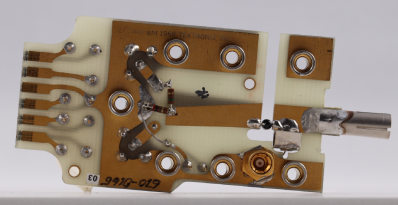If you want to do something you’ve never done before, there are two broadly-defined ways of approaching it: either you learn everything you can about it and try to do it right the first time, or you get in there and get your hands dirty, and work out the details along the way. There’s a lot to be said for living life by the seat of your pants. Just ask anyone who found inspiration in the 11th hour of a deadline, simply because they had no other choice.
Ted Yapo didn’t have a lot of high-speed design knowledge when he set out to build an open-source multi-GHz sampling oscilloscope, but he didn’t let that stop him. Fast forward a year or so, and Ted’s ready to build his third prototype armed with all the hands-on practical knowledge he’s gained from building the first two.
At the 2019 Hackaday Superconference, Ted gave a talk about his journey into the high-stakes world of high-speed design. It’s an inspiring talk, and Ted gives a good look into everything he’s learned in trying to build a sampling ‘scope. We think you’ll appreciate not only Ted’s work, but also the ease with which he explains it all.
So why is Ted doing all of this? For one thing, his 1989 Tektronix has been trucking along for 75,000+ hours, and it won’t last forever. The bigger problem is that this is one of the last digital scopes to use equivalent-time sampling, because manufacturers jumped to real-time sampling within a few years. Ted sees the opportunity to duplicate this with modern technology, and we are over here nodding vigorously and setting aside cash for whenever this thing is ready to either buy outright or build.
Equivalent-Time Sampling
The first scope Ted ever used was a 1968 Tektronix, so that’s where he started his studies. His journey began with that age-old question: how do equivalent-time sampling ‘scopes work, exactly? He found schematics and descriptions for that vintage, and then bought a used one and dismantled it.
What Ted found inside the sampling head seems shockingly simple. There are two Schottky diodes doing the sampling, and they are fed short current pulses by a separate strobing circuit controlled by a step recovery diode.
Ted quickly discovered that the biggest hurdle would be generating these extremely fast pulses. He found that while it’s harder for the hobbyist to get bleeding-edge components that get the speed down to single-digit picosecond range, it’s definitely possible to get to the 20-30 ps range with affordable components.
Analog to Digital Conversion
Armed with enough knowledge to be dangerous, Ted built an analog sampler using a six-Schottky diode gate and a couple of 74HC logic chips to generate the strobing pulses. Ted says it took half an hour to take his first sample because the UI is completely manual — he sampled using a potentiometer, read the values off of a voltmeter, and wrote them all down, covering five sheets of paper. But it worked, …read more
Source:: Hackaday

